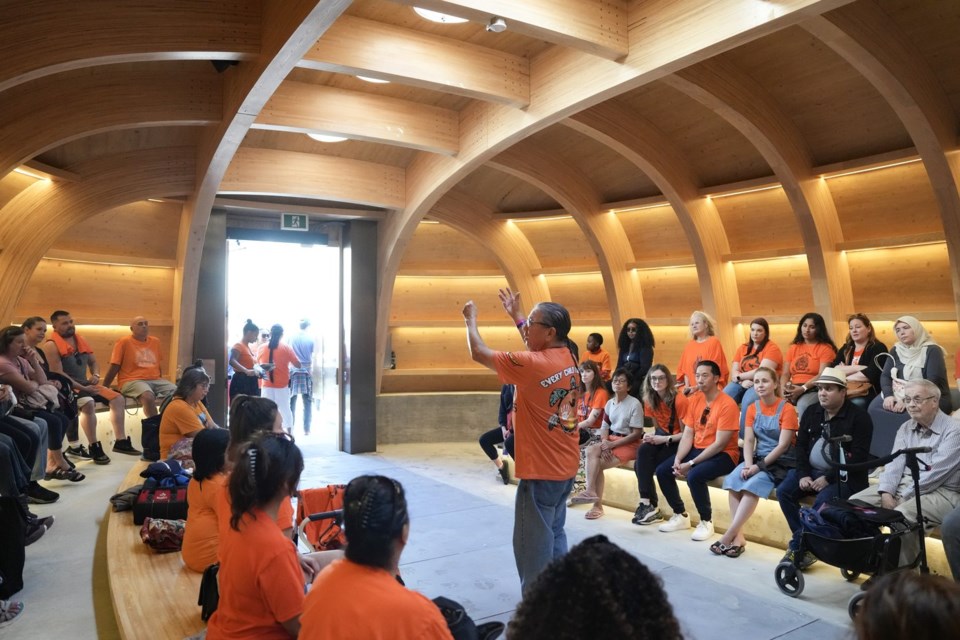TORONTO — A monument to honour residential school survivors was unveiled in Toronto's Nathan Phillips Square on Monday, one of dozens of events in Ontario marking the National Day for Truth and Reconciliation.
The new spirit garden in front of Toronto City Hall comes in response to the Truth and Reconciliation Commission's call for governments to establish publicly accessible, highly visible monuments honouring survivors and thousands of children who died in residential schools.
The garden's centrepiece is a large turtle sculpture positioned in a reflecting pool that has the names of the 18 residential schools that once operated in Ontario inscribed on its north wall.
Jordan Carrier brought her children and grandchildren to the square on Monday to take part in the ceremony and for them to "learn more about their own identity as First Nations people."
"For me, today is not so much a celebration, but an honouring of the past," she said.
Carrier said her grandmother, a residential school survivor, was the last fluent Cree speaker in her family. Her grandmother, she said, feared that her children and grandchildren might be abused like she was for speaking Cree if they, too, learned the language.
But Carrier, who has a tattoo on her wrist of the Cree syllabics for family, said she has sought out books and online language classes in a bid to reclaim the language.
"I always think of the generations that came before us and the residential school survivors ... and how hard that was for them and that we need to do the healing," she said.
Beginning in the 19th century, more than 150,000 Indigenous children were separated from their families and communities and sent to church-run residential schools, where abuse, malnutrition and inadequate health care were rampant.
The Truth and Reconciliation Commission found in its landmark 2015 final report that the school system, which operated for more than 150 years, was a central element of a state-backed policy that amounted to attempted cultural genocide.
Ontario Regional Chief Abram Benedict said the lasting intergenerational effects of the schools "must never be forgotten."
"Our unique Nations and cultures exist today because survivors of the residential school system fought to keep them alive — often in the face of serious personal harm," Abrams wrote in a statement.
"They passed on the traditions, languages and teachings these institutions sought to destroy so that all of us today know who we are, where we come from and how we got here."
Monday is also recognized as Orange Shirt Day, which began as an Indigenous-led grassroots effort to recognize the lasting effects of residential schools.
The initiative began in 2013, inspired by Phyllis Webstad's story of having the orange shirt her grandmother gave her taken away when she arrived at a residential school in 1973 at the age of six.
Sarita Censoni, who visited Nathan Phillips Square on Monday with a friend, said she was using the day to learn more about the residential school system and the injustices inflicted on Indigenous communities throughout Canada's history.
“I am here because this an important day for all Canadians,” she said.
Allan Okitchiquo was also at the square and said his aunt was among the residential school students who were abused at the institutions and never returned.
“I am here to represent all of children that didn’t come home and all the survivors," he said.
In a statement, Premier Doug Ford said a number of Ontario government buildings would be lit orange. He encouraged people to "learn more and reflect on this dark and disturbing period in our country's history and acknowledge the intergenerational harm it has caused."
The day is a federal statutory holiday, but not a provincial one in Ontario.
New Democrat deputy leader Sol Mamakwa, the only First Nation representative at the provincial legislature, said he aims to table legislation in his own Indigenous language to have the day declared a paid provincial holiday.
— with files from Liam Casey.
This report by The Canadian Press was first published Sept. 30, 2024.
Sharif Hassan and Jordan Omstead, The Canadian Press



